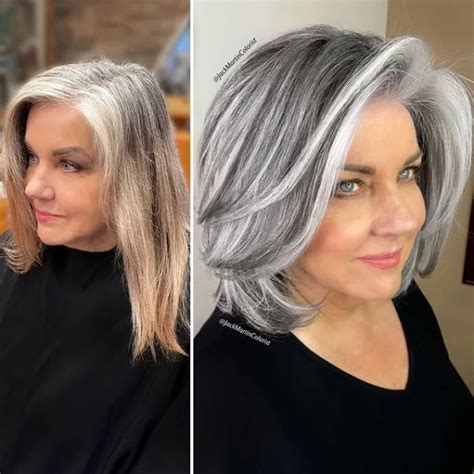Silver Revolution: Embracing Gray
In an era where youthful appearances are often idealized, a growing number of women are proudly embracing their gray hair. This natural phenomenon, once associated with aging, is now celebrated as a sign of experience and wisdom.

Statistics:
– According to a 2021 study by Dove, 60% of women over 50 prefer to let their hair go gray.
– The “gray hair movement” has gained momentum on social media, with over 2 million posts tagged #grayhair on Instagram.
Causes of Gray Hair
The graying process, medically known as canities, is caused by a decrease in melanin production in the hair follicles. Melanin is the pigment that gives hair its color. As we age, the production of melanin slows down, resulting in the formation of gray hair.
Types of Gray Hair
- Salt-and-pepper: Hair with a mix of natural color and gray strands.
- Pepper: Hair with predominantly gray strands.
- Silver: Hair that has completely turned gray and has a silvery sheen.
Benefits of Gray Hair
- Natural beauty: Gray hair adds a unique and distinguished touch to one’s appearance.
- Low maintenance: Eliminates the need for costly and time-consuming hair coloring treatments.
- Empowerment: Embracing gray hair can be an empowering experience, signifying a rejection of societal beauty standards.
Transitions to Gray Hair
Gradual transition: Let your gray hair grow out naturally over time, blending it with your natural color.
Semi-permanent color: Enhance gray hair with semi-permanent color, adding subtle shades of silver or beige.
Hair painting: Use a balayage or ombré technique to create a gradual transition from darker roots to lighter tips.
Styling Gray Hair
- Embrace texture: Gray hair tends to be finer, so embrace its natural texture with volumizing products.
- Highlight strands: Add a touch of glamour with highlights in hues of platinum or lavender.
- Consider bangs: Bangs can frame the face and draw attention to gray hair.
Common Mistakes to Avoid
- Over-washing: Wash hair less frequently to avoid stripping away natural oils.
- Exposure to heat: Limit the use of heat styling tools, as they can damage gray hair.
- Ignoring hair care: Continue to use nourishing hair products, such as conditioners and masks, to keep gray hair healthy.
Pros and Cons of Gray Hair
Pros:
- Natural beauty and empowerment
- Low maintenance costs
- Reduced chemical damage
Cons:
- May not be perceived as professional in certain settings
- Can make hair appear thinner
- May require special hair care products
Future Innovations for Gray Hair
Gray-enhancing shampoos: Shampoos that contain blue or purple pigments can enhance gray hair, neutralizing unwanted yellow tones.
Precision hair coloring: Nanotechnology may allow for more precise hair coloring, reducing the need for multiple dye applications.
Personalized hair care: Technology-driven hair care devices and apps can analyze gray hair and provide customized recommendations.
Case Studies
Success stories:
– Sarah Jessica Parker: The actress has gracefully embraced her gray hair, becoming an icon of the gray hair movement.
– Jamie Lee Curtis: The actress has been vocal about her decision to stop dyeing her hair, embracing her natural gray.
Personal perspectives:
– “Embracing my gray hair was one of the most empowering decisions I’ve made. It’s a celebration of my age and experience.” – Jennifer, 55
– “I initially resisted going gray, but I’m now so glad I did. My hair has never looked healthier.” – Mary, 60
Conclusion
Gray hair is a beautiful and natural sign of aging that can be embraced with confidence and pride. By understanding the causes of gray hair, exploring different transition options, and avoiding common mistakes, women can celebrate their gray hair and enjoy its many benefits. As the gray hair movement continues to gain momentum, we can expect to see even more innovations and advancements in gray hair care and styling.
